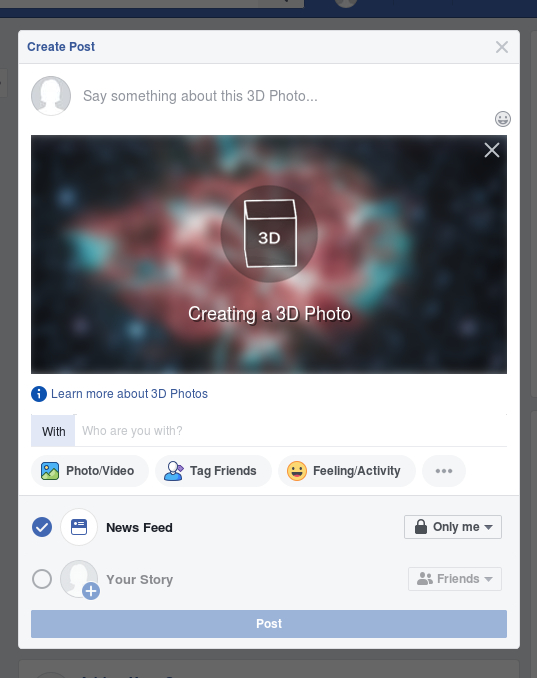- Usage
- Exporting 3D
Exporting to 3D-capable media
Besides rendering images as anaglyphs or side-by-side 3D stereo content, the Stereo 3D module is also able to generate Facebook 3D photos, as well as interactive self-contained 2.5D and Virtual Reality experiences.
Standalone Virtual Reality experience

The 'WebVR' button in the module exports your image as a standalone HTML file. This file can be viewed locally in your webbrowser, or it can be hosted online.
It renders your image as an immersive VR experience, with a large screen wrapping around the viewer. The VR experience can be viewed in most popular headsets, including HTC Vive, Oculus, Windows Mixed Reality, GearVR, Google Day Dream and even sub-$5 Google Cardboard devices.
To view an experience, put it in an accessible location (locally or online) and launch it from a WebVR/XR capable browser.
Please note that landscape images tend to be more immersive.
Standalone interactive 2.5D web viewer
The 'Web2.5D' button in the module exports your image as a standalone HTML file. This file can be viewed locally in your webbrowser, or it can be hosted online.
Depth is conveyed by a subtle, configurable, bobbing motion. This motion subtly changes the viewing angle to reveal more or less of the object, depending on the angle. The motion is configurable both by you and the viewer in both X and Y axes. The motion can also be configured to be mapped to mouse movements.
A so called 'depth pulse' can be sent into the image, which travels through the image from the near plane to the far plane, highlighting pixels of equal depth as it travels. The 'depth pulse' is useful to re-calibrate the viewer's persepective if background and foreground appear swapped.
Hosting the file online, allows for embedding the image as an IFRAME. The following is an example of the HTML required to insert an image in any website;
<iframe scrolling="auto" marginheight="0" marginwidth="0" style="border:none;max-width:100%;" src="https://download.startools.org/pillars_stereo.html?spdx=4&spdy=3&caption=StarTools%20exports%20self-contained,%20embeddable%20web%20content%20like%20this%20scene.%20This%20image%20was%20created%20in%20seconds.%20Configurable,%20subtle%20movement%20helps%20with%20conveying%20depth." frameborder="0"></iframe>
The following parameters can be set via the url;
- modex: 0=no movement, 1=positive sine wave modulation, 2=negative sine wave modulation, 3=positive sine wave modulation, 4=negative sine wave, 5=jump 3 frames only (left, middle, right), 6=mouse control
- modey: 0=no movement, 1=positive sine wave modulation, 2=negative sine wave modulation, 3=positive sine wave modulation, 4=negative sine wave, 5=mouse control
- spdx: speed of x-axis motion, range 1-5
- spdy: speed of y-axis motion, range 1-5
- caption: caption for the image
Facebook 3d photos

The Stereo 3D module is able to export your images for use with Facebook's 3D photo feature.
The 'Facebook' button in the module saves your image as dual JPEGs; one image that ends in '.jpg' and one image that ends in '_depth.jpg' Uploading these images as photos at the same time will see Facebook detect and use the two images to generate a 3D photo.
Please note that due Facebook's algorithm being designed for terrestrial photography, the 3D reconstruction may be a bit odd in places with artifacts appearing and stars detaching from their halos. Nevertheless the result can look quite pleasing when simply browsing past the image in a Facebook feed.
3D-capable TVs and projectors
TVs and projectors that are 3D-ready can - at minimum - usually be configured to render side-by-side images as 3D. Please consult your TV or projector's manual or in-built menu to access the correct settings.
You may also be interested in...
- Stage one (under Main operation)
Noise grain caused by shot noise (aka Poisson noise) - the bulk of the noise astrophotographers deal with - exists on all size levels, becoming less noticeable as the size increases.
- Usage (under Stereo 3D)
The 'Intricacy' parameter controls how much smaller scale detail should prevail over larger scale detail.
- Usage (under FilmDev)
Central to the module, is the 'Digital Development' parameter, which controls the strength of the development and resulting stretch.
- Usage (under Entropy)
The 'Dark/Light Enhance' parameter enables you to choose the balance between darkening and brightening of areas in the image.
- usage (under Heal)
By using the advanced parameters, the Heal module can be made useful in a number of advanced scenarios.
